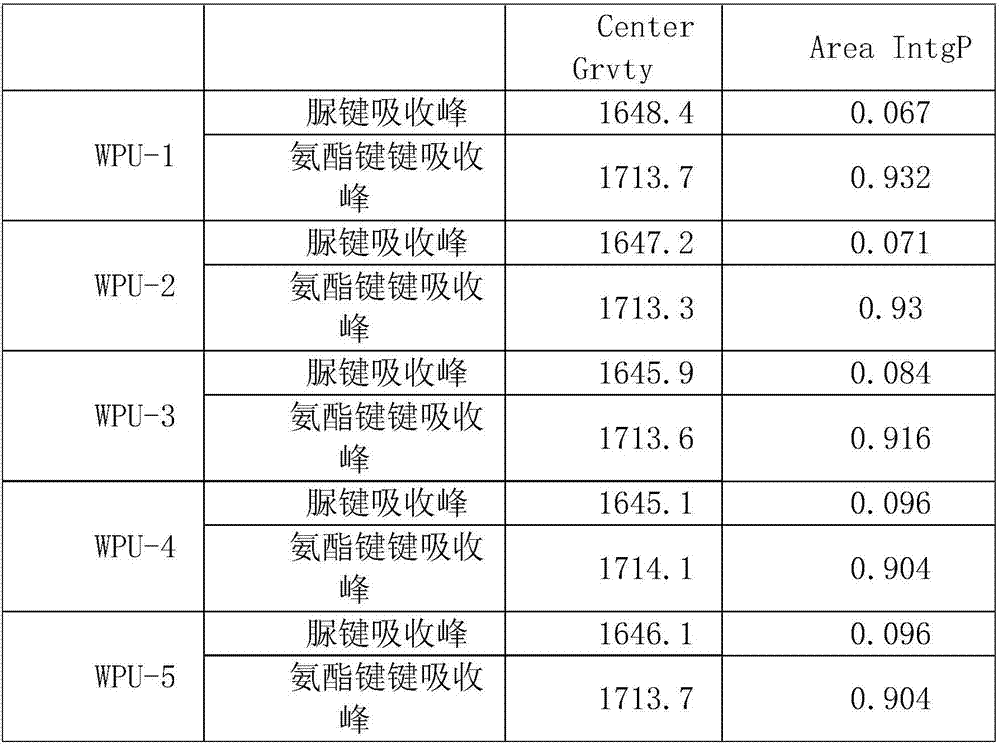Preparation method of secondary-post-chain-extension waterborne polyurethane and dispersing liquid prepared from waterborne polyurethane
A technology of water-based polyurethane and post-chain extension, which is applied in the field of polyurethane preparation, can solve problems such as the difficulty in fully improving the relative molecular weight of water-based polyurethane, and achieve improved water-based polyurethane product performance, large commercial application value, and improved tensile strength and elongation at break rate effect
- Summary
- Abstract
- Description
- Claims
- Application Information
AI Technical Summary
Problems solved by technology
Method used
Image
Examples
Embodiment 1
[0033]With 100g (0.05 mole) the polycarbonate diol of relative molecular mass 2000, the polypropylene oxide diol of 110g (0.11 mole) relative molecular mass 1000, the polypropylene oxide diol of 5g (0.0017 mole) relative molecular mass 3000 and 100 g (0.1 mol) of polytetrahydrofuran diol with a relative molecular mass of 1000 was vacuum dehydrated at 120° C. for 1.5 h. Cool down to 65°C, add 159.5g (0.718 moles) of isophorone diisocyanate, and react under nitrogen protection at 80°C for 1 hour. Add 0.1 g of stannous octoate (0.000247 mol) and react at 80° C. for 1.5 h. Add 12g (0.081 mol) of 2,2-dimethylolbutyric acid, 6g (0.057 mol) of diethylene glycol, and 60g of butanone, and react at 80°C for 3 hours to obtain a clear and viscous prepolymer. Cool down to 50°C, add 9.0g of triethylamine for neutralization, disperse the prepolymer in 1134g of deionized water under high-speed stirring at 1000r / min, add 8.6g (0.143 moles) of ethylenediamine to extend the chain, and stir at h...
Embodiment 2
[0035] 100 g (0.2 mol) of polybutylene adipate with a relative molecular mass of 500 was vacuum dehydrated at 120° C. for 1 h. Cool down to 60°C, add 72g (0.414 moles) of toluene diisocyanate, and react under nitrogen protection at 80°C for 1 hour. Add 0.03g (0.0000475 moles) of dibutyltin dilaurate and react at 80°C for 1.5h. Add 4g (0.03 moles) of 2,2-dimethylolpropionic acid, 3g (0.03 moles) of neopentyl glycol, 5g of N-methylpyrrolidone, and 25g of methyl ethyl ketone, and react at 80°C for 3h to obtain a clear and viscous pre- Polymer. Cool down to 50°C, add 3.6g of triethylamine for neutralization, disperse the prepolymer in 104g of deionized water under high-speed stirring at 1000r / min, add 3.9g (0.045 moles) of piperazine and extend the chain, and stir at high speed for 0.5h , adding 5g (0.028 moles) of 3,5-diethyltoluenediamine for secondary chain extension, stirring at high speed for 1 h, and removing the solvent under reduced pressure to obtain an aqueous polyuret...
Embodiment 3
[0037] 200 g (0.1 mol) of polypropylene oxide diol with a relative molecular mass of 2000 was vacuum dehydrated at 120° C. for 1.5 h. Cool down to 65°C, add 76.4g (0.344mol) of isophorone diisocyanate, and react under nitrogen protection at 80°C for 1 hour. Add 0.06g (0.000148 moles) of stannous octoate and react at 80°C for 1.5h. Add 8g (0.06 moles) of 2,2-dimethylolpropionic acid, 5g (0.06 moles) of 1,4-butanediol, 10g of N-methylpyrrolidone, 40g of methyl ethyl ketone, and react at 80°C for 3h to obtain a clear viscous Thick prepolymer. Cool down to 50°C, add 7.2g of triethylamine for neutralization, disperse the prepolymer in 245g of deionized water under high-speed stirring at 1000r / min, add 3.0g (0.05 mole) of ethylenediamine to extend the chain, and stir at high speed for 0.5 h, add 5.2g (0.029 moles) of 3,5-diethyltoluenediamine for the second chain extension, stir at high speed for 1 h, remove the solvent under reduced pressure, and obtain the aqueous polyurethane d...
PUM
 Login to View More
Login to View More Abstract
Description
Claims
Application Information
 Login to View More
Login to View More - R&D
- Intellectual Property
- Life Sciences
- Materials
- Tech Scout
- Unparalleled Data Quality
- Higher Quality Content
- 60% Fewer Hallucinations
Browse by: Latest US Patents, China's latest patents, Technical Efficacy Thesaurus, Application Domain, Technology Topic, Popular Technical Reports.
© 2025 PatSnap. All rights reserved.Legal|Privacy policy|Modern Slavery Act Transparency Statement|Sitemap|About US| Contact US: help@patsnap.com



